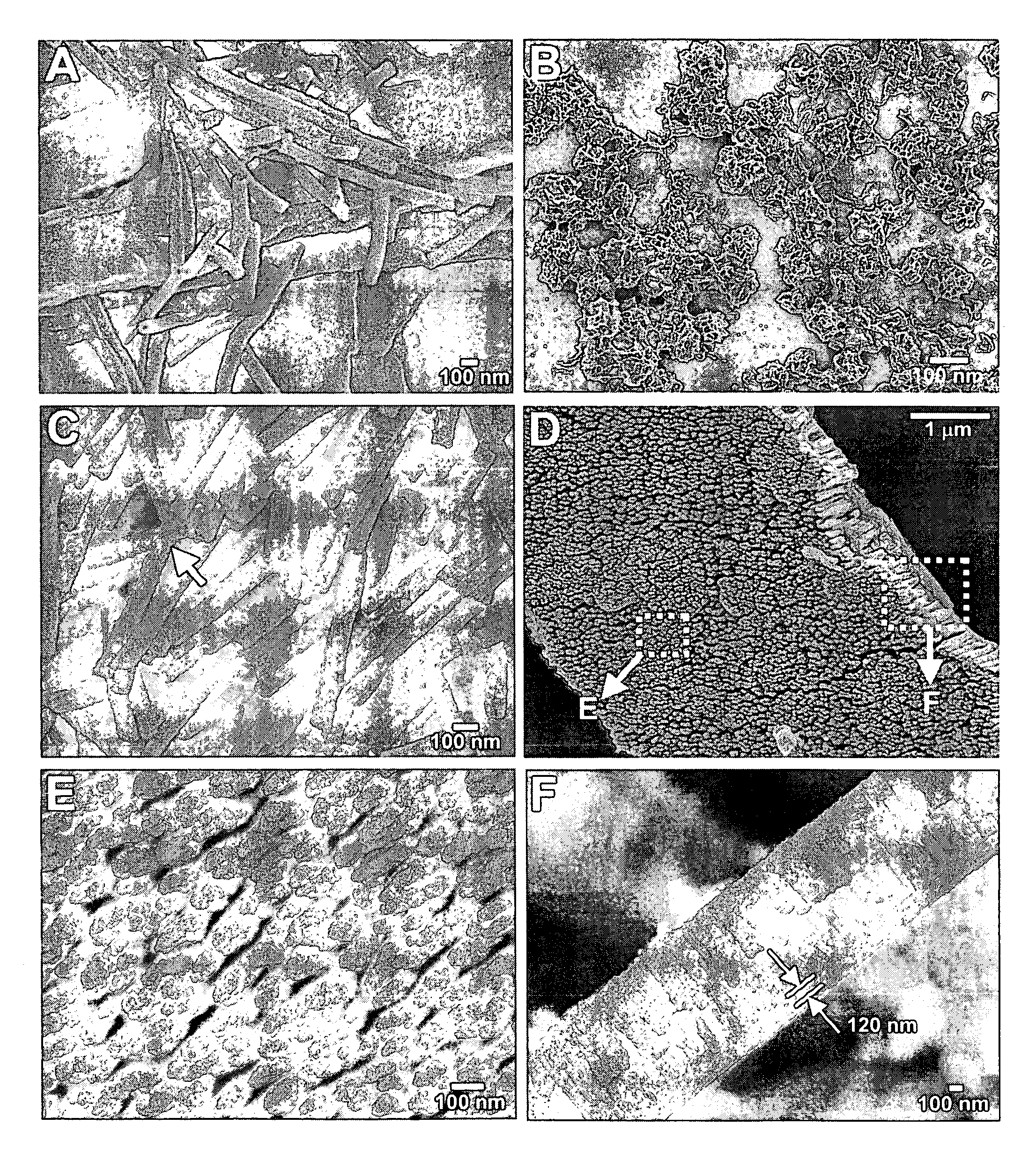Self assembled nanostructures and mehods for preparing the same
a technology of diacetylene compounds and nanotubes, which is applied in the direction of fatty acid chemical modification, inorganic carrier, amide active ingredients, etc., can solve the problems of non-homogeneous preparation, difficult to generate uniform nanotube structures from these precursors, and difficult to prepare optically active phospholipid variants. , to achieve the effect of polymerization of nanotubes and high yield of polymerized nanotubes
- Summary
- Abstract
- Description
- Claims
- Application Information
AI Technical Summary
Benefits of technology
Problems solved by technology
Method used
Image
Examples
example 1
Nanotubes Produced Using Mixtures of Compounds 2, 3, 4, and 5
[0085] The synthetic schemes are summarized in FIG. 1.
[0086] Compound 2 was produced when 3.0 g of 10,12-pentacosadiynoic acid (PDA) was converted to a succinimidyl ester by reaction with 2.77 g of N-hydroxysuccinimide (NHS) and 4.61 g of 1-[3-(dimethylamino)propyl]-3-ethylcarbodiimide (DEC) in chloroform (250 ml) for 12 hours. The resulting compound was added over the course of 30 minutes to 300 ml ethylene diamine-chloroform solution (6%, w / v). After reaction overnight at room temperature, the mixture was extracted with 250 ml of chloroform. The organic phase washed with distilled water (100 ml) for five times and dried with NaSO4 and rotary evaporation to yield a white powder (compound 2).
[0087] Compound 2 (3 g) was then subjected to a quaternization reaction at room temperature by mixing with 5 ml of ethyl bromide in 15 ml of nitromethane. Reaction solvents were removed by a rotary evaporation and the resulting whit...
example 2
Nanotubes Produced Using the Secondary Amine Salt of PDA Alkylated with an Ethyl Head Group
[0088] PDA (2.77 g) modified with NHS in the presence of DEC (as above) was slowly added to a 10 fold excess of N-ethyl-1,2-ethylenediamine in dichloroethane. After an overnight reaction, the mixture washed five times with 100 ml of water. The organic phase was dried with sodium sulfate and rotary evaporated to yield a white powder (compound 6, as shown FIG. 1 panel B).
[0089] Pure compound 3 was prepared from compound 6. Compound 6 (1.0 g) is dissolved in 20 ml of chloroform and an equal volume of aqueous HBr was added. The mixture was shaken vigorously to transfer the HBr to the organic phase. The organic phase was removed and concentrated in a rotary evaporator from 20 ml to 3 ml. Hexane (300 ml) was added to the chloroform solution to precipitate compound 3 and the precipitate was dried in vacuum at room temperature. To prepare nanotubes, the dried precipitate was suspended in 20 ml of wa...
example 3
Control of the Diameter of the Nanotube
[0091] PDA modified with NHS in the presence of DEC was slowly added to 10 times excess of N-propyl-1,2-ethylenediamine, or N-butyl-1,2-ethylenediamine, in dichloroethane, respectively. After the reaction, the mixture washed with water. The organic phase was dried with sodium sulfate and rotary evaporated to yield a white powder. The HBr amine salt of PDA alkylated with an n-propyl, or an n-butyl, head group and nanotubes made from the n-propyl derivatives of PDA or the n-butyl derivatives of PDA were prepared as described in Example 2. Under SEM the nanotubes were absolutely monodisperse in wall thickness (n-propyl PDA based nanotubes: 31 nm; n-butyl PDA based nanotubes: 33 nm) and internal diameter (n-propyl PDA based nanotubes: 34 nm; n-butyl PDA based nanotubes: 16 nm). The diameter of the nanotubes is uniform throughout the sample and the length varies from 200 nm to 1.8 μm.
PUM
| Property | Measurement | Unit |
|---|---|---|
| Wavelength | aaaaa | aaaaa |
| Amphiphilic | aaaaa | aaaaa |
| Polarity | aaaaa | aaaaa |
Abstract
Description
Claims
Application Information
 Login to View More
Login to View More - R&D
- Intellectual Property
- Life Sciences
- Materials
- Tech Scout
- Unparalleled Data Quality
- Higher Quality Content
- 60% Fewer Hallucinations
Browse by: Latest US Patents, China's latest patents, Technical Efficacy Thesaurus, Application Domain, Technology Topic, Popular Technical Reports.
© 2025 PatSnap. All rights reserved.Legal|Privacy policy|Modern Slavery Act Transparency Statement|Sitemap|About US| Contact US: help@patsnap.com



